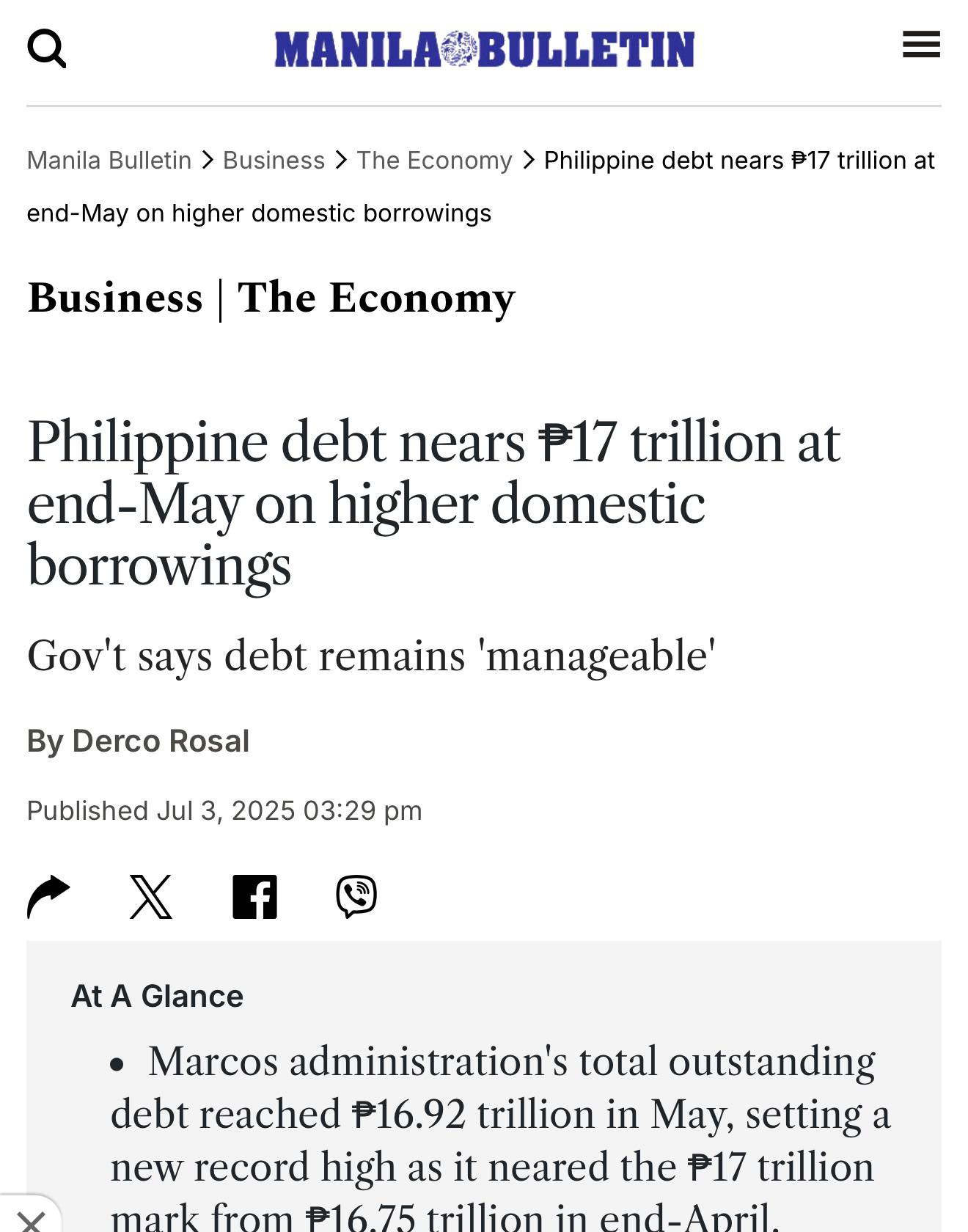The Manila Bulletin headline indicates that the Philippine government's outstanding debt reached ₱16.92 trillion at the end of May 2025, approaching the ₱17 trillion mark, another record high. Although the government insists the debt remains “manageable,” this trajectory raises multiple red flags for the Philippine economy. WHY? Because…
First, the country’s fiscal burden is growing, and debt servicing pressures are heightened further. As total debt rises, so does the cost of debt servicing, the payment of interest and principal. In 2024, the Philippines already allocated over ₱1.8 trillion for debt servicing, and this figure will inevitably rise in 2025 with higher interest rates and mounting obligations. A larger share of the national budget will be used to pay off debt instead of investing in infrastructure, healthcare, education, or poverty alleviation. This leads to a “crowding-out” effect on public spending for essential services.
Second, there’s an increasing risk of credit rating downgrades. As debt balloons, credit rating agencies closely monitor the country’s fiscal discipline. If revenue fails to catch up or if the Marcos administration’s fiscal consolidation strategy remains weak or vague, the country may face downgrades. A lower credit rating makes it more expensive for the government and local firms to borrow money from international markets. It could also spook foreign investors, leading to capital flight or reduced Foreign Direct Investment (FDI) inflows, which is already happening at the moment.
Third, the article notes that higher domestic borrowings drive the increase. When governments borrow heavily from domestic markets, it can lead to: (1) rising interest rates, as the government competes with private borrowers for funds; (2) liquidity constraints, drying up capital for businesses and households; and (3) potential inflationary effects, especially if borrowing is monetized (i.e., funded by the central bank), weakening the peso further.
Fourth, it leads to further peso depreciation and imported inflation. A weaker peso increases the cost of imports, particularly for energy and food, which are crucial for the Philippines. This triggers imported inflation, which disproportionately affects poor and middle-income households already struggling with the rising costs of living.
Fifth, reduced fiscal space in times of crisis. With debt nearing unsustainable levels, the Philippines may lack the fiscal flexibility to respond to future shocks, such as natural disasters, global recessions, pandemics, or wars. The government may be forced to choose between austerity (spending cuts) or more borrowing, both of which can worsen social and economic conditions.
Sixth, to maintain fiscal credibility, the government may consider raising revenues through higher or new taxes, often regressive ones such as VAT hikes, or through austerity measures. This burdens ordinary citizens and small businesses, suppresses consumption, and can slow down economic recovery or growth.
Note that the Philippines has yet to significantly improve industrial productivity, agricultural resilience, or logistics infrastructure, key areas necessary to stimulate self-sustaining growth and reduce import dependence. Without robust structural reforms, debt-financed growth remains superficial and unsustainable, creating a cycle of borrowing without development.
History shows that debt crises, especially when mismanaged, can lead to public discontent, especially when paired with rising inequality, unemployment, and declining public services. As more people question where borrowed money under Marcos Jr.’s government is going and how it benefits them, it may lead to political backlash and further erosion of trust in government institutions.
Let’s be frank, folks, the Marcos administration’s assurance that the debt is "manageable" must be viewed with caution. While debt per se is not inherently bad if used productively, the quality of spending, transparency of fiscal management, and economic returns from such borrowings are more critical. Without these, the Philippines risks spiraling into a debt trap, one that undermines both its economic sovereignty and developmental future.





Omg, everything is deterioating! Imagine for 3 yrs., a gargantuan chunk of yearly budget had been used to persecute political party enemies and advance election related expenses (like Ayudas used to buy votes omg). Almost all public services are poor, GOCCs funds are being transferred or diverted yo unknown purpose, previous gov't. projects were suspended and stopped, the Maharlika Investment Funds is now a GHOST at marami pang hindi na mabilang na kapalpakan that concerns the welfare of the Nation. It is ripe now for BBM to STEP DOWN!